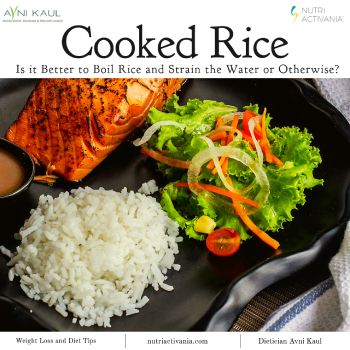Rice is a staple food in many cultures, and the method of cooking it varies widely across regions and households. One common practice is boiling rice and then straining off the water before serving, known as the parboiling method. Let us explore the considerations behind this technique and whether it is the best approach for your culinary needs as explained by Delhi’s top nutritionist and dietician, Avni Kaul, in this blog.
What are the Benefits of Parboiling Rice?
- Lower Glycemic Index: Parboiling rice and discarding the water may reduce its glycemic index. This can be advantageous for individuals managing diabetes or seeking to control blood sugar levels more effectively.
- Arsenic Reduction: Rice can absorb arsenic from the soil, especially in regions with elevated levels of this toxic compound. Parboiling rice has been suggested as a method to reduce arsenic levels, potentially offering a safer option for consumption.
- Texture and Flavor: Some prefer the texture and flavor of parboiled rice, which tends to be firmer and less sticky compared to rice cooked by other methods. This can enhance the dining experience, particularly in dishes where distinct, separate grains are desired.
What are the Drawbacks to Consider?
- Nutrient Loss: Parboiling rice and discarding the water may lead to the loss of water-soluble vitamins and minerals, including B vitamins and certain trace minerals like potassium and magnesium. This could impact the nutritional value of the final dish.
- Water and Time Consumption: Parboiling rice requires more water and time compared to other cooking methods such as absorption or steaming. This may not be ideal for individuals looking to conserve water or shorten cooking times.
- Flavor and Aroma Loss: Discarding the water used for parboiling may result in the loss of flavor compounds and aroma, potentially diminishing the overall sensory experience of the cooked rice.
Choosing the Right Method
Deciding whether to boil rice and strain the water or not depends on various factors, including personal preferences, dietary considerations, and culinary goals. It is essential to weigh the potential benefits and drawbacks of parboiling rice against other cooking methods.
While parboiling may offer advantages such as a potentially lower glycemic index and reduced arsenic content, it is essential to be mindful of nutrient loss and longer cooking times. Ultimately, selecting the best method for cooking rice involves considering these factors and choosing the approach that aligns with your priorities and needs.
Whether you opt to strain the water when boiling rice or not, exploring different cooking methods can add diversity to your culinary repertoire and enhance your enjoyment of this versatile grain. Experimentation and adaptation based on individual preferences and dietary requirements are key to mastering the art of cooking rice to perfection.
- Amazing Indian Foods to Lower Your Blood Pressure Level Naturally - April 26, 2024
- Fruits That Can Help You Lose (or Maintain Your) Weight - April 23, 2024
- What are the Potential Health Benefits of Raw Sprouts? - April 20, 2024

